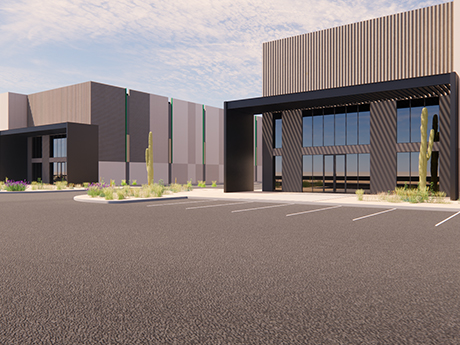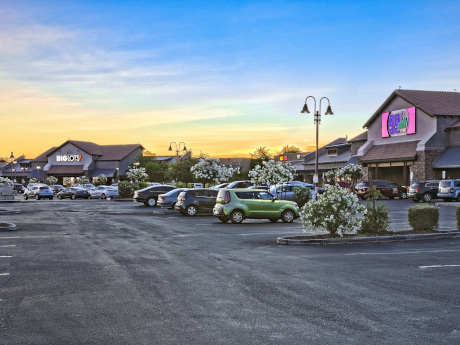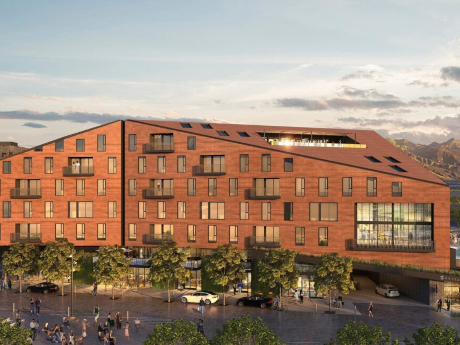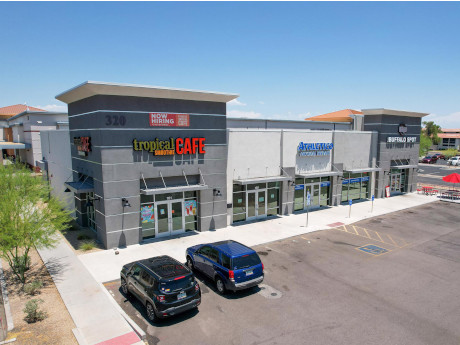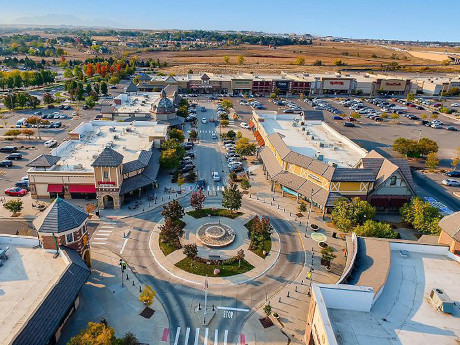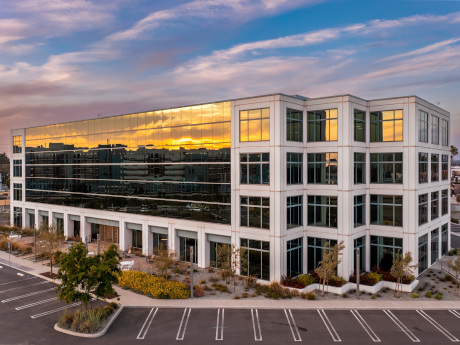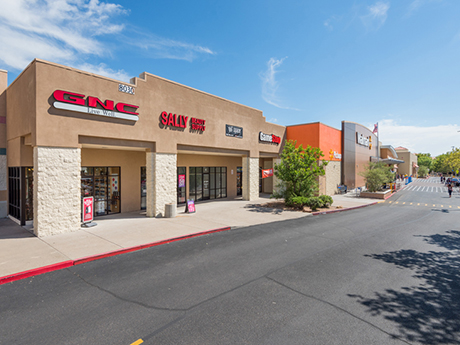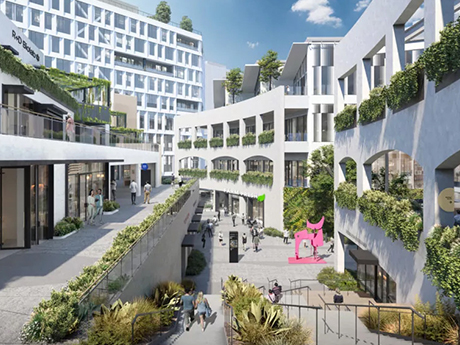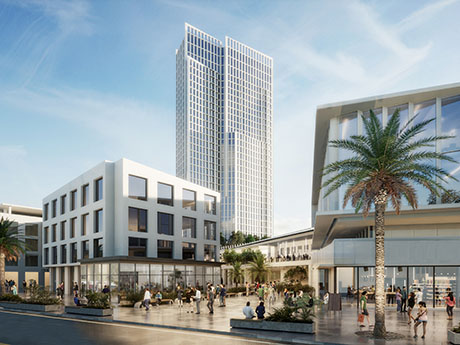DIV Industrial has seen the demand, and is delivering for Fortune 100 tenants that need to be accommodated in the Phoenix market. The Irvine, Calif.-based investor and developer just closed on 47 acres in Goodyear that will soon serve as the home of Sarival Business Park, a 847,988-square-foot, Class A industrial complex. At completion, the modern, LEED-certified business park will include five free-standing buildings ranging from 135,000 square feet to 235,000 square feet. This transaction marks DIV’s first foray into the Phoenix market. Nicholas Ilagan, the firm’s co-founder and managing partner, notes there were many attributes that attracted him to this region. “The Phoenix MSA continues to be one of the fastest-growing metros in the country,” he says. “The region is propelled by its established infrastructure, business-friendly approach, educated workforce, and accessibility to Southern California’s port markets and the Western U.S. population. Phoenix is attracting large corporations and Fortune 500 companies that are relocating or setting up new, efficient operations, such as data centers, distribution facilities and manufacturing operations.” This includes Taiwan Semiconductor Manufacturing Company, which Ilagan notes has had a “huge boost to the local economy and stimulated employment growth.” Goodyear has also drawn in larger regional and national …
Western Market Reports
— By Dave Cheatham, President, Velocity Retail Group and X Team Retail Advisors — Phoenix’s retail market has rebounded post-pandemic and is now considered a winning bet, along with industrial and multifamily. The market has benefitted from surging consumer demand, population expansion and a robust technology industry, largely fueled by accelerated growth in the chip manufacturing sector. Strong and positive economic performance has established a foundation on which retailers have built success across the Valley of the Sun. There are challenges, to be sure, which range from interest rate hikes and rising inflation to chaos in the capital markets and reduced investment transaction volume, in addition to increased construction costs. New construction has been limited, as evidenced by the fact that no Target, Lowe’s or Home Depot stores have been built in the Valley since the recession. That appears to be changing as plans for big box stores that had been idle for a decade are shifting to expansion mode once more. Second-generation space is in high demand due to the higher costs of building new, standalone stores. Market indicators are trending upward for the retail sector. Vacancies are at a record low, demand remains high and rents are continuing …
— By Blake Bozett, founder and CEO, The Zett Group — The Boise metro (Boise, Eagle, Meridian, Garden City) is made up of 75 licensed assisted living facilities, 42 of which have more than 30 licensed beds. Of those 42 assisted living facilities, the ownership type is made up of: national owner/operator (18), local owner/operator (12), REIT (4), regional owner/operator (3), local development company (2), privately held real estate investment firm (1), 1031 investment platform (1) and non-profit (1). These ownership stats aren’t necessarily unique to other metros such as Seattle and Portland with institutional capital typically owning a large share of the buildings. What’s interesting to me on a micro level is that the single asset, one to two off owners are more interested in selling than years past. What started as a simple mom-and-pop operating business a few decades ago has turned into a sophisticated and challenging operating business with extreme expense, inflationary and regulatory pressures. Having come from the operations side of the business I’ve seen many of these challenges firsthand. Therefore, it no surprise why the local owner who has owned his/her assisted living facility for 20 years may have greater appetite for selling despite less …
— By Greg Swedelson and Jon-Eric Greene, co-founders, SSG Realty Partners — Although there continues to be much speculation and concern about the impacts of inflation, high debt costs, rising unemployment and an economy that may be heading for a slowdown in the coming year, there is reason to believe that the outlook for the Salt Lake City commercial real estate market is quite positive. With more than $100 billion in annual GDP, Salt Lake City’s economic growth rate is poised to end the year up nearly 3.5 percent (and nearly 80 percent since 2011). Although many are projecting a more moderate growth rate of 2.8 percent entering 2024, the overall economy and commercial real estate market in SLC remain resilient, if not robust. Offering a combination of affordability, abundant job opportunities and a business-friendly environment, SLC has attracted some of the nation’s largest corporations and specialized tech companies, and with them, talent to fuel meaningful employment growth. So much so, in fact, that net employment is up nearly 10 percent over the pre-Covid levels of 2019, with no sign of slowing. Like so many markets, SLC has seen a precipitous drop in investment sales volume across all commercial sectors …
— By Brian Polachek, Senior Vice President, SRS Real Estate Partners — The holiday season is upon us, and as 2023 draws to a close the real estate community turns its focus towards the future, particularly to what 2024 holds. Let’s look at recent developments and future expectations of the Phoenix retail market, a sector that has shown remarkable growth and resilience. Phoenix’s retail landscape has experienced a significant growth period, primarily due to a combination of factors including substantial population increases, strong consumer spending, minimal store closures and limited new retail space has been built. This surge in growth is largely attributed to Phoenix’s rising appeal as a place to live as well as a business-friendly environment. The influx of new residents and businesses has created a robust consumer base, driving up spending and providing a diverse market for retailers. Remarkably, the Valley has seen positive absorption for nine consecutive quarters, totaling 4.2 million square feet in the past year alone. As a result, Phoenix has become one of the leading U.S. markets in retail demand, bringing vacancy rates down to a record low of 4.5 percent, according to CoStar. This ongoing demand signifies not only the market’s current …
— By Tami Lord, Senior Vice President, SRS Real Estate Partners — No longer the Cowtown of ages past, Denver has developed into an economically diverse, midsized city as demonstrated by both the residential and business growth over the last decade. Major companies now include Denver on their target list for potential headquarters, regional hubs, and distribution locations. Compared to the coastal markets, Denver is more affordable and offers a very desirable quality of life for employees, helping to put Denver on the short list. The pandemic only increased Denver’s growth trajectory. All of a sudden, people were able to maintain their current employment while living in a setting known for over 300 days of sun annually with easy access to hiking, skiing, biking, camping…the list goes on. The population growth has spurred rising housing and land prices. Coupled with rising construction costs, increasing real estate taxes, long permitting times and a tight employment market, traditional retail development has slowed. The lack of significant new development has pushed retail vacancy to a near-record low of 4.1 percent across the metro, according to data from CoStar. Many downtown retail markets across the country have been hit with higher vacancy rates in …
— By Robert Ritschel and Andrew Herron, Senior Vice Presidents, The Saywitz Company — The industrial sector for Orange County commercial real estate continues to be one of the strongest in the country. Vacancy rates in Orange County for industrial space remain at approximately 2 percent. What this means for tenants out in the marketplace is a continued struggle to find viable space. When combining limited availability with the fact that some of the buildings are older or obsolete, or may have lower ceiling height or reduced power, this makes the challenge even more difficult. With that said, we have seen the sales prices for industrial space level off and we have also now, for the first time in the past several years, begun to see landlords offer free rent and move-in concessions, and come off of their asking prices. The days of five or 10 different tenants looking at one available space in the marketplace seem to be over, and those with good credit looking to sign long-term leases clearly stand out from the mom-and-pop operator that may be looking to sign a short-term lease. Landlords on the industrial side appear to be much more conscious of the changing …
— By Anthony Johnson, President, Pegasus Group and Western Regional Director, X Team Retail Advisors; and AJ Johnson, Associate Broker, Pegasus Group — Looking back on the Albuquerque retail market for 2022 and 2023, I have to say that 2022 was the height of our boom in terms of the sale/lease of shopping center and freestanding pad sales, built-to-suit opportunities and redevelopment opportunities. The top consumers of these product types were chicken (QSR), coffee, car washes and cannabis, or as we affectionately called them, the “Four C’s.” Due to the sheer amount of activity in the pad user market, underutilized was a key word during this time. We saw vacant pad sites that were once considered unleasable or unsellable, perking the interest of investors, tenants and developers. By 2022 the negative effects of the pandemic had subsided, which resulted in the most robust year we’ve ever seen in terms of pad sales/leases. I’ve never seen anything like it. It was like a crescendo… and then, the “music” stopped. It was February of 2023 when the music started to get fainter. By August 2023, the music stopped, and now we’re seeing the aftermath of this. Meaning, many of the pad sites …
— By Jeff Lefko, Executive Vice President, Hanley Investment Group Real Estate Advisors — Hanley Investment Group is expanding and opening its newest office in San Diego in early 2024. San Diego, the eighth most populous city and the fifth largest county in the United States, ranks second only to Los Angeles County in California, boasting a population nearing 3.28 million. With a substantial GDP of $206 billion, San Diego holds the 17th largest metropolitan area position in the U.S. and the fourth largest in California. The city’s economy thrives on defense, tourism, international trade and research/manufacturing sectors. Notably, in 2022, San Diego experienced an 8 percent growth in life science employment, reinforcing its position as a premier life science research destination. Attracting 28.8 million annual visitors, it stands as a prominent U.S. travel destination, generating approximately $13.6 billion in yearly spending and employing 214,000 San Diegans directly and indirectly. San Diego’s robust economy, diverse population, quality education, and prime location render it a desirable hub for commercial retail investment. The business-friendly climate further enhances its allure, while the limited supply of new retail construction helps maintain stable real estate fundamentals. The changing economy and rising interest rates have caused …
— By Jeffrey Swinger, Executive Vice President | Las Vegas, Multifamily Investment Sales, Colliers — Las Vegas is on a roll right now, continuing to raise the bar year after year, and we are bullish on the long-term outlook of Southern Nevada’s future. UNLV’s Center for Business and Economic Research predicts that Southern Nevada’s population will gain 41,900 new residents in 2023 and increase another 2.4 percent in 2024. This wave of growth, coupled with strong local economic activity and enhanced infrastructure investments, has created more jobs and more demand for housing. With more than $8.12 billion of new major projects delivered in 2023, there is another $2 billion currently under construction with plans to deliver in 2024 and 2025. Additionally, there is another $17.25 billion of announced and proposed projects keeping Las Vegas’s momentum moving forward. Significant projects that were delivered in 2023 include the Fontainebleau, the MSG Sphere and the inaugural Formula 1 Heineken Silver Las Vegas Grand Prix. The Fontainebleau is the latest hotel/casino along the Strip, valued at $3.7 billion, and will add 3,644 rooms to the hotel inventory count. The MSG Sphere is Las Vegas’s newest entertainment venue featuring the largest spherical building in the …


